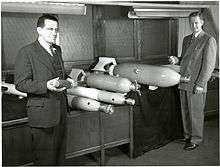Harry Diamond (engineer)
| Harry Diamond | |
|---|---|
|
Harry Diamond, c.1940 | |
| Born |
February 12, 1900 Russia |
| Died | June 21, 1948 (aged 48) |
| Cause of death | Heart Attack |
| Resting place | Arlington Cemetery |
| Alma mater | Massachusetts Institute of Technology (1922) |
| Occupation | Engineer |
| Spouse(s) | Ida Diamond |
| Children |
Zelda Fichandler Joyce Diamond |
Harry Diamond (12 February 1900 – 21 June 1948) was an American radio pioneer and inventor, and namesake for Diamond Ordnance Fuze Laboratories.
Early life
Diamond was born in Russia on February 12, 1900 and immigrated to the United States as a child. He grew up in Quincy, Massachusetts. Mr. Diamond enlisted in the United States Army on October 14, 1918 and was honorably discharged on December 9, 1918. He graduated with a degree in Electrical Engineering from Massachusetts Institute of Technology in 1922. Diamond worked for the General Electric company for 18 months.[1] He completed his master's degree in Electrical Engineering in 1925 and an Electrical Engineering instructor for 4 years at Lehigh University in electrical engineering.[2]
Bureau of Standards
He joined the National Bureau of Standards in 1927. Diamond headed up the research and development work of the Commerce Department’s newly organized Bureau of Air Commerce.[3] Within two years he developed radio beacon system that permitted the first "blind" aircraft landing.[2][4][5] Diamond and his team made the first visual-type radiobeacon system that enabled a pilot to keep on course and to know his approximate position at all times while in flight. direction service could be given to any number of planes flying the course, and that each airplane only had to carry a receiving set, with no other special equipment whatsoever. The pilot would obtain the necessary information pertaining to amplitude of course deviations hands-free and without requiring earphones. To accomplish this the development of vibrating-reed indicators alerting the pilot to an off-course condition.[6]
Proximity Fuze development
Diamond went on and became Chief of the Electronics Division. The National Bureau of Standards was brought into the program, and Harry Diamond was given responsibility for this phase of the Bureau’s work. Within about four months of the start of the program, Diamond’s group established feasibility of the radio proximity fuze through conclusive tests in bombs dropped at the Naval Proving Ground at Dahlgren, Va. Throughout World War II, this group acted as the central laboratory of Division 4 of the National Defense Research Committee, and Diamond was the central figure of the group. Much of the basic proximity fuze technology was developed under his direction.

Later, as Chief of the Ordnance Development Division he was assigned the task of supervising the development of proximity fuzes for nonrotating projectiles such as bombs, rockets, and mortars. It was calculated that a fuze which would explode a projectile near a plane or at some height above a target on the surface would increase lethality.
Mr. Diamond, through his vast knowledge in the field of electronics, contributed greatly to the fundamental concept and design of proximity fuzes. He held 16 patents for electronics-related inventions. The Ordnance Development Division, upon transfer from the National Bureau of Standards to the Army in 1953, was named the Diamond Ordnance Fuze Laboratories in honor of Mr. Diamond. It has since been renamed the Harry Diamond Laboratories.[7] The War Department later described inventor Harry Diamond's proximity fuze as "one of the outstanding scientific developments of World War II ... second only to the atomic bomb" in military importance.[8]
Diamond's daughter Zelda Fichandler along with her husband Thomas C. Fichandler in 1950 co-founded the Arena Stage in Washington DC.[9]

Mr. Diamond died suddenly June 21, 1948.[10]
References
- ↑ Brittain, James E. (September 1993). "Scanning the Past". Proceedings of the IEEE. 81 (9).
- 1 2 Cochrane, Rexmond Canning (1966). Measures for Progress: A History of the National Bureau of Standards, Issue 275. washington DC: National Bureau of standards. pp. 295–297. LCCN 65-62472.
- ↑ Oser, Hans J. (2001). Development of the Visual-Type Airway Radio-Beacon System, special publication number 958. Washington D.C.: National Institute for standards and Technologies. pp. 38–42.
- ↑ Elfin, Margery L. (2006). Forest Hills. Arcadia Publishing. p. 70. ISBN 0-7385-4299-7.
- ↑ Diamond, Harry; Francis W. Dunmore (December 1937). "Experiments with Underground Ultra-High-Frequency Antenna for Airplane Landing Beam". Proceedings of the Institute of Radio Engineers. 25 (12): 1542–1560. doi:10.1109/JRPROC.1937.228820.
- ↑ Radiobeacons and radiobeacon navigation. Washington DC: U.S. Government Printing Office. 1931. pp. 39–40.
- ↑ "Ordnance Corps Tribute". US Military. Retrieved March 3, 2013.
- ↑ "Patriot file". Retrieved March 3, 2013.
- ↑ "The Hour". The Washington Post. June 30, 1976.
- ↑ "Obituary". The Washington Post. June 22, 1948.
